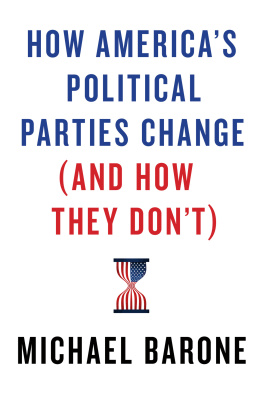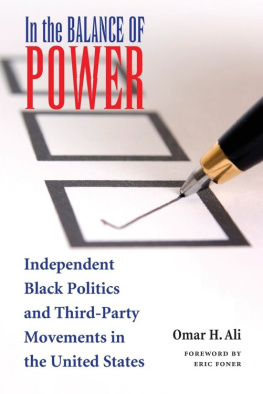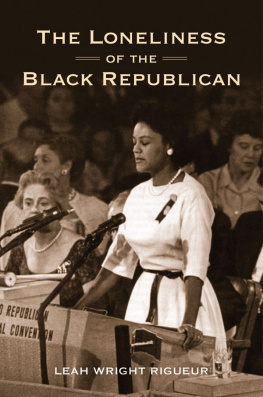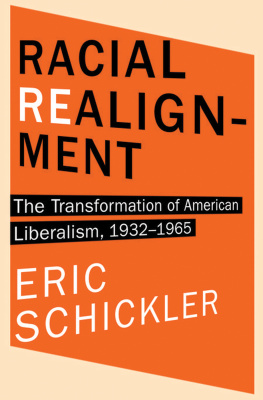
HOW AMERICAS POLITICAL PARTIES CHANGE
(AND HOW THEY DONT)
MICHAEL BARONE
New York London
2019 by Michael Barone
All rights reserved. No part of this publication may be reproduced, stored in a retrieval system, or transmitted, in any form or by any means, electronic, mechanical, photocopying, recording, or otherwise, without the prior written permission of Encounter Books, 900 Broadway, Suite 601, New York, New York, 10003.
First American edition published in 2019 by Encounter Books, an activity of Encounter for Culture and Education, Inc., a nonprofit, tax-exempt corporation.
Encounter Books website address: www.encounterbooks.com
Manufactured in the United States and printed on acid-free paper. The paper used in this publication meets the minimum requirements of ANSI/NISO Z39.481992
(R 1997) (Permanence of Paper).
FIRST AMERICAN EDITION
LIBRARY OF CONGRESS CATALOGING-IN-PUBLICATION DATA
Names: Barone, Michael, author.
Title: How Americas political parties change (and how they dont) / by Michael Barone.
Description: New York : Encounter Books, 2019. | Includes bibliographical references and index.
Identifiers: LCCN 2019013893 (print) | LCCN 2019016278 (ebook) | ISBN 9781641770798 (ebook) | ISBN 9781641770781 (hardcover : alk. paper)
Subjects: LCSH: Political partiesUnited StatesHistory. | United StatesPolitics and government.
Classification: LCC JK2261 (ebook) | LCC JK2261 .B3444 2019 (print) | DDC 324.273dc23LC record available at https://lccn.loc.gov/2019013893
Page design and composition: BooksByBruce.com
For Alex P.
CONTENTS
INTRODUCTION
Panic is a poor guide to reality. In the nine oclock hour on the evening of November 8, 2016, as it became clear that Hillary Clinton was not going to win the electoral votes of Florida and Pennsylvania and that Donald Trump was going to be the 45th president of the United States, something like panic set in for millions of Americans and foreigners who had not until that point imagined that such an outcome was possible. Panicky predictions were made about what President Trump might do and about how our entire political system might be destabilized. Panicky predictions were made that huge shifts in voting behavior meant either that Republicans had gained forever a monopoly of white working-class votersor that Republicans were doomed to be the minority party for the rest of history, if they were to remain an active political party at all.
For those of us with some years of experience observing postelection commentary, all this had a certain familiarity. I am old enough to have observed the predictions of the death of the Republican Party after the election of 1964 and of the permanent minority status of the Democratic Party after its electoral reverses in the 1980s and 1990s. I have read enough history to know how plausible such predictions were after the 60 to 34 percent defeat of the Democratic Party in 1920 and the 57 to 40 percent defeat of the Republican Party just twelve years later, in 1932.
In fact the change in party percentages between 2012 and 2016or between any presidential election since 1996 and that of 2016was minimal by historical standards. Donald Trumps percentage of the popular vote was 1 percent lower than Mitt Romneys in 2012, while Hillary Clintons share was 3 percent lower than Barack Obamas that year. The most recent generation of our politics has been characterized by what I have called polarized partisan parity, to an extent that is arguably unprecedented in American history. There were far greater oscillations in party percentages between the elections of 1976 and 1980, for example, or between those of 1988 and 1992.
Its true that there were bigger shifts in the levels of support for each partys nominee by certain segments of the electorateshifts that produced, to almost everyones surprise, an Electoral College majority for Donald Trumpbut these were not of unprecedented magnitude either. Trump, as compared with Romney or other recent Republican nominees, won fewer votes from white college graduates and additional votesjust a little morefrom white non-college-graduates. But his losses among the former group cost him no electoral votes, while his gains among the latter netted him the 100 electoral votes of Florida, Pennsylvania, Ohio, Michigan, Wisconsin, Iowa, and the 2nd congressional district of Maine. His margins were small and arguably tenuous, as indicated by the net loss of 40 or 41 House seats by the Republican Party in 2018, as Republican House candidates failed to match Trump levels of support from non-college whites and, more significantly, suffered further losses among white college graduates.
The panicky responses are in need of perspective. In my commentary at public forums at the American Enterprise Institute and in my columns in the Washington Examiner, I have argued that we are not in the midst of a gigantic electoral upheaval but something more in the nature of a course correction and that our political parties have persisted and adapted through more daunting challenges. Americans seem to be placidly unaware that we have the oldest and third oldest political parties in the world, with the Democratic Party dating from the 1832 national convention that nominated Andrew Jackson for a second term and the Republican Party dating from 1854 protests against the Kansas-Nebraska Act allowing slavery in the territories. Their only competitor in longevity is the British Conservative Party (itself in a period of turmoil today), which its leading historian, Robert Blake, dates to reaction against the repeal of the Corn Laws in 1846. Parties as long-lasting as these, I submit, even as they shift positions in response to events and elections, represent something basic in the character of the nations they have governed with considerable and recurring success.
These arguments are hard to convey in short-form journalism and rapid-fire commentary. It is especially difficult to make reference to historic persons and events that are not immediately familiar even to generally well-informed citizens. Fortunately I have had the opportunity over the past two years to address them at greater length, in what I hope is an accessible manner however unfamiliar the material. One of my great pleasures in life is what I call my vagrant readingprowling through books with no direct or immediate connection to my work and among my favorite types of books are the slim volumes consisting of a few lectures by eminent historians like H. R. Trevor-Roper and J. H. Elliott, Bernard Bailyn and Edmund Morgan. There are few more delightful ways to spend an evening than settling into a comfortable chair and reading in one sitting a brilliant scholars distillation of a lifetime of learning, enlivened by a gift for the arresting example. Such books are the models I had in mind when preparing these essays, versions of which were delivered as lectures.
My subject is the long historyand the striking resilienceof our two political parties. When I first started reading history as a child, I wondered why other sorts of partiesa socialist party, a progressive party, a traditionalist party, a religious partyhad not developed in the United States. One answer is that our electoral systemthe Electoral College, the single-member congressional (and senatorial) district works powerfully against the emergence of such alternatives. This is one reason why this country did not spawn a major socialist party in the early twentieth century, as most European democracies did, and why the Progressive Party, led by Americas leading vote-getter up to that point, Theodore Roosevelt, vanished less than half a dozen years after its second-place finish in the election of 1912.
Next page










